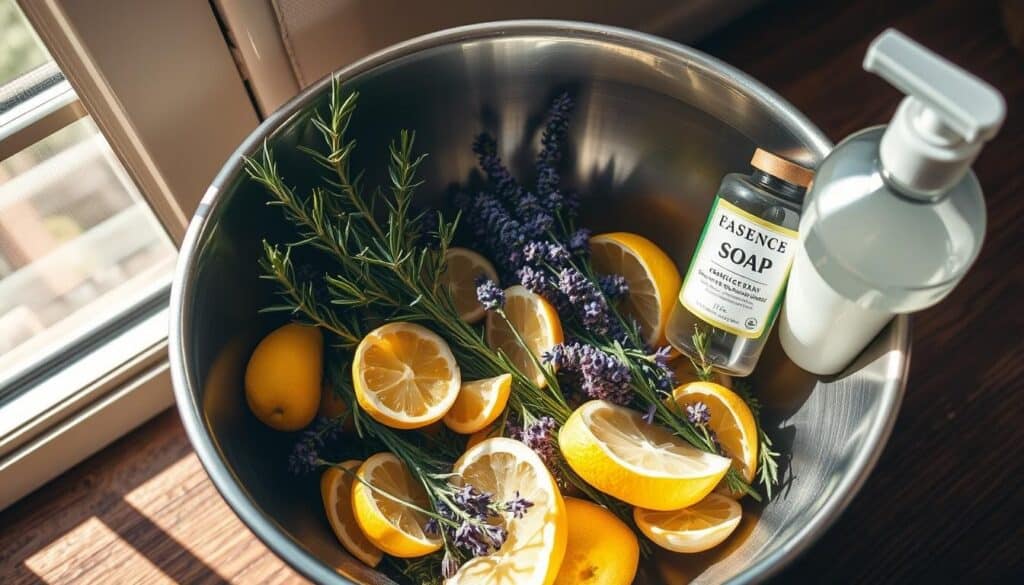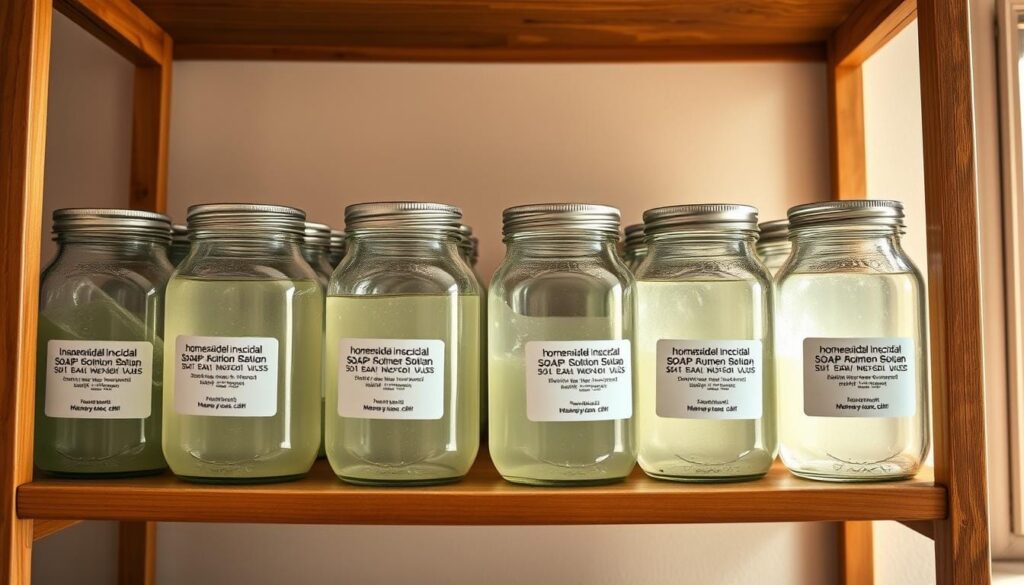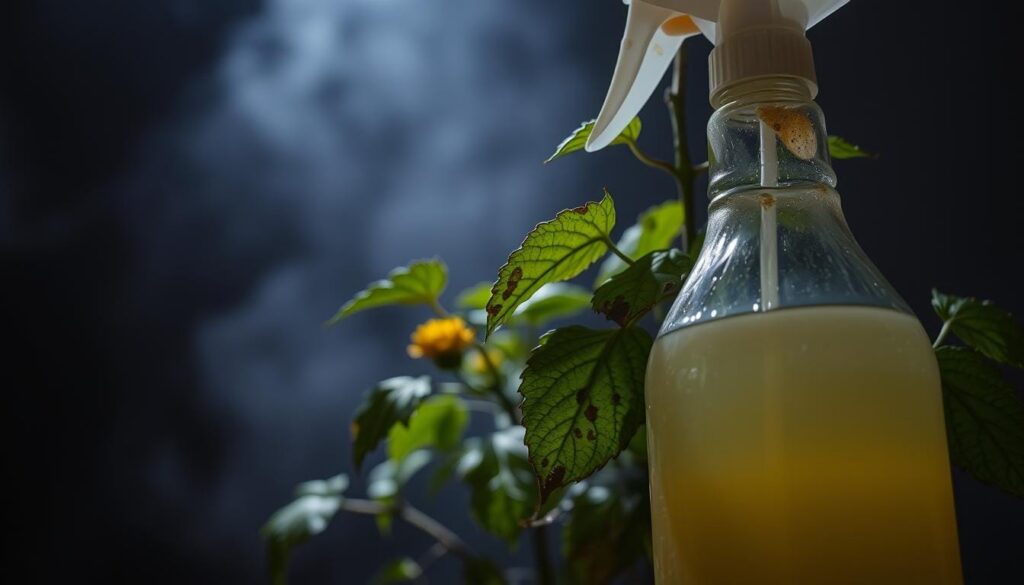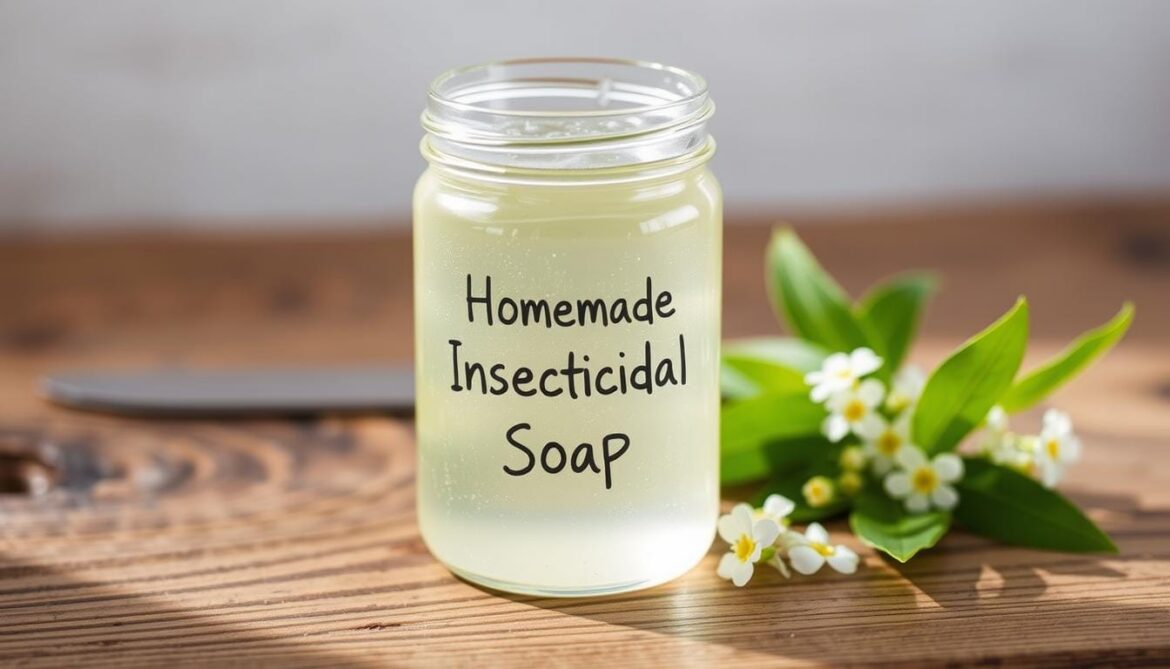Have you seen your plants fight off aphids or spider mites? Many gardeners struggle with this, unsure of what to do. They don’t want to use harsh chemicals or try ineffective home remedies.
What if you could protect your garden with something simple and safe? Homemade insecticidal soap is a solution that’s gentle on the earth but tough on pests. It lets you have a thriving garden without using harmful pesticides. This method turns everyday kitchen items into a powerful tool for healthy plants.
Key Takeaways
- Homemade insecticidal soap uses affordable, accessible ingredients.
- Effective against common pests like aphids and whiteflies without harming the environment.
- Reduces exposure to synthetic chemicals for safer gardening.
- Simple to make and adjust based on plant needs.
- Works as part of a broader organic pest control strategy.
What is Homemade Insecticidal Soap?
Homemade insecticidal soap is a natural way to fight pests. It’s made from things you might have at home. This homemade plant spray targets soft-bodied insects but is gentle on plants and the environment. It’s a favorite among gardeners who want to use eco-friendly methods.
Definition and Purpose
This solution is a mix of mild dish soap and water. It’s different from commercial pesticides because it breaks down the protective layers of pests like aphids and spider mites. Its goal is to offer a safe, effective way to control pests without using harsh chemicals.
Benefits of Using Homemade Solutions
- Cost-effective: Uses ingredients already in your kitchen.
- Customizable: Adjust concentrations based on plant sensitivity.
- Environmentally safe: Breaks down quickly without lingering toxins.
As a homemade plant spray, it helps reduce the need for store-bought products. This cuts down on costs and waste.
How It Works on Pests
The soap disrupts the cell membranes of pests, causing dehydration and death. It needs to make direct contact with insects. This means you might need to apply it more than once. But, if you dilute it right, it won’t harm most plants.
Common Pests Targeted by Insecticidal Soap
Insecticidal soaps are great for fighting soft-bodied insects. They are a key part of DIY bug repellent routines. They work well without harming plants or pollinators. Here’s how they tackle four garden pests:
Aphids
Aphids cluster on new growth, sucking plant juices and leaving sticky residue. Their soft bodies dissolve when sprayed directly. Look for curled leaves or ants feeding on honeydew. Treat weekly until pests vanish.
Spider Mites
Spider mites thrive in dry conditions, creating webbing on leaf undersides. These tiny pests drain plant fluids, causing yellow spots. Soap breaks down their protective layers—apply early to prevent population explosions.
Whiteflies
Whiteflies flutter when disturbed, clustering on leaf undersides. Their feeding weakens plants, causing wilting. Use a fine mist spray to reach hidden colonies. Repeat applications every 5–7 days.
Mealybugs
Mealybugs form cottony white clusters in plant crevices. Their waxy coating resists single treatments. Use a cotton swab to spot-treat before spraying. Multiple applications ensure full eradication.
For persistent infestations, combine soap with neem oil for longer-lasting control. Always test on a small plant area first to avoid leaf burn.
Ingredients for Homemade Insecticidal Soap
Creating homemade insecticidal soap is easy with the right insecticidal soap ingredients. Choosing the right mix keeps plants safe while fighting pests. Here’s what you need:
Liquid Dish Soap
Castile soaps like Dr. Bronner’s or Seventh Generation are best. Stay away from soaps with antibacterial or scents. These soaps kill pests without harming plants. Make sure the soap doesn’t have moisturizers, as they reduce its power.
Water
Use distilled or softened water to avoid mineral buildup. Tap water with lots of minerals can block plant pores. Mix 1-2 tablespoons of soap with a gallon of water. Test it on a small area first to avoid burning leaves.
Optional Additives
- Neem oil: Keeps pests away.
- Peppermint or rosemary oil: Repels insects with its smell.
- Garlic extract: Keeps pests away naturally.
- Vegetable oil: Helps the soap stick to plants better.
Be careful with additives. Too much oil can hurt your plants. Always test small batches before using it all.
How to Make Homemade Insecticidal Soap

Learning to make a natural insecticide recipe is easy with basic kitchen items. It fights pests like aphids without using harsh chemicals. Here’s how to make a safe, effective spray:
| Ingredient | Quantity |
|---|---|
| Liquid dish soap (unscented) | 1-2 tablespoons |
| Water | 1 quart |
Step-by-Step Instructions
- Pour 1 quart of lukewarm water into a spray bottle.
- Add 1-2 tablespoons of mild liquid soap, shaking gently to mix.
- Test on a small plant area first to check for leaf damage.
- Apply directly to infested plants, focusing on leaf undersides.
Tips for Measuring Ingredients
- Use a measuring spoon for precise soap amounts.
- Too much soap may harm plants—stick to 2% concentration.
- Store leftover mix in a labeled bottle for future use.
Safety Precautions
Always wear gloves when mixing. Avoid spraying on sunny days to prevent leaf burn. Keep mix out of reach of children and pets. For reference, Meyer lemon trees respond well to this method when applied correctly.
“Regular application and proper monitoring of plants can enhance effectiveness,” advise gardening experts.
Application Techniques for Best Results
Proper application is key for the homemade garden pest remedy to work well. Follow these steps for the best results without harming your plants.
Spray Application
Use a pump sprayer or trigger bottle for even coverage. Spray the undersides of leaves where pests hide. Shake the mixture well before spraying to keep it mixed. Avoid windy days to prevent spray from hitting other plants.
- Test on a small area first to check for plant sensitivity.
- Apply during early morning or late afternoon to reduce sunburn risk.
- Rinse plants lightly after 1–2 hours if residue causes leaf spots.
Direct Application Method
For delicate plants, use a soft cloth or sponge dipped in the solution. Gently wipe the affected areas to remove pests. This method reduces spray runoff and protects sensitive foliage. Avoid oversaturating the soil to prevent root rot.
Frequency of Use
Reapply every 5–7 days until pests disappear. Increase frequency in humid climates where pests multiply quickly. Reduce applications during extreme heat or drought to avoid plant stress. Monitor pest levels weekly to adjust schedules.
Always prioritize safety. For more details on soap formulations, see Gardening Know-How’s guide on soap spray basics. Consistent application ensures long-term pest control without harsh chemicals.
Effectiveness of Insecticidal Soap

Insecticidal soap works by breaking down pest cell membranes. Its success depends on how well it’s used. Direct contact is key—most pests die within hours if fully exposed.
For the best results, apply during early morning or late afternoon. This is when pests are most active.
How Quickly Does It Work?
You’ll see results in 24 hours. To keep pests away, apply every 4–7 days. This is because soap only affects pests it directly hits.
Check your plants daily. This way, you can spot any pests that haven’t been treated.
Factors Affecting Effectiveness
- Concentration: Too strong a mix can harm plants. Always follow the recommended ratios.
- Application Coverage: Spray the undersides of leaves. This is where pests like to hide.
- Weather: Avoid applying during rain or high heat. These conditions reduce how long the soap stays on the plants.
Comparison to Chemical Insecticides
Unlike synthetic pesticides, homemade solutions don’t last long. But they’re safer for pollinators and the soil. This makes them a good choice for eco-friendly insect control.
To manage pests better, use soap with other methods. Try weeding and planting companion plants. For more tips, check out Chikus Garden’s weed guide. It helps you find plants that can fight pests naturally.
Safety Considerations
Using a homemade insect killer spray needs careful attention to safety. It works well, but you must apply it right to protect everyone and the planet. Here’s how to keep pest control safe and responsible.
Friendliness to Beneficial Insects
Insecticidal soap mainly hits soft-bodied pests. But, it’s kinder to helpful bugs like ladybugs and bees. Spray early morning or evening when they’re not busy. And don’t spray on flowers to keep bees safe.
Toxicity to Humans and Pets
Homemade mixes are safe if you dilute them right. But, it’s important to be careful.
- Wear gloves and a mask when mixing.
- Keep it away from kids and pets.
- Don’t spray near where food is made.
Wash plants well before eating them if you’ve sprayed them.
Environmental Impact
Soap-based solutions break down fast and don’t stick to soil. They’re safer for water than chemical pesticides. But, too much can hurt plants. So, spray only where needed, not everywhere.
Storage and Shelf Life
Properly storing homemade insecticidal soap is key to its effectiveness and safety. Follow these tips to keep your solution potent and ready to use.

Proper Storage Techniques
Keep homemade insecticidal soap in opaque containers to shield it from light. Light can break down the mixture. Also, label containers with the date and ingredients.
Store them in a cool, dry place. Avoid areas near heat or where it could freeze.
Signs of Spoilage
- Separation of liquid and residue at the bottom
- Unusual cloudiness or discoloration
- Unpleasant odors or mold growth
Throw away solutions showing these signs. This prevents ineffective or harmful use.
Duration Before Expiration
Most homemade insecticidal soap stays good for 1–2 weeks. Adding garlic or alcohol can slightly extend its life. For longer storage, split it into smaller batches and use within 2 weeks.
Always make fresh solutions for the best results. Check containers often for signs of spoilage. Discard expired solutions and make new ones to keep pest control effective.
Alternatives to Insecticidal Soap
Looking into organic pest control beyond homemade insecticidal soap reveals many options. Here are some effective alternatives for different gardening needs.
Other Homemade Pest Control Methods
Here are some DIY pest control methods:
- Garlic spray: Crushed garlic mixed with water repels aphids and beetles.
- Neem oil: Diluted in water, it disrupts insect life cycles for long-term control.
- Diatomaceous earth: A natural powder that damages pests’ exoskeletons when applied to soil.
- Herbal repellents: Catnip or peppermint sprays deter ants and other crawling insects.
Commercial Options Available
For those who prefer convenience, here are some branded products:
| Product | Key Ingredients | Effectiveness | Cost |
|---|---|---|---|
| Safer Brand Neem Oil | 100% cold-pressed neem | High for soft-bodied pests | $12–$18 |
| Bonide Eighty Plus | Pyrethrin + insecticidal soap | Broad-spectrum action | $15–$25 |
Integrating Integrated Pest Management
Using a mix of methods leads to sustainable results:
- Cultural practices: Rotate plants to disrupt pest cycles.
- Physical barriers: Use row covers to block pests like whiteflies.
- Biological controls: Introduce ladybugs to prey on aphids naturally.
Choosing the right combination of these strategies ensures long-term protection. It avoids relying on just one method.
Troubleshooting Common Issues

Homemade plant sprays can sometimes cause problems. Here’s how to spot and solve common issues:
Ineffective Treatment
Poor results often come from mistakes in making the spray. Here are some fixes:
- Check soap-to-water ratios: Use 1–2 tablespoons of dish soap per gallon of water.
- Ensure full pest coverage. Spray all leaf surfaces, including undersides.
- Apply during dry weather. Reapply every 3–5 days if pests persist.
Leaf Burn and Other Damages
Some plants don’t like soap residues. Here’s a guide:
| Plant | Issue | Action |
|---|---|---|
| Rosemary | Leaf spotting | Test on a small area first |
| Gardenias | Yellowing | Rinse foliage after spraying |
If burns happen, rinse plants with water and use less soap. Don’t spray in the hottest part of the day.
Resistance Development
Resistance is rare but can happen. Here’s how to prevent it:
- Rotate with neem oil or horticultural oil every 2–3 weeks.
- Monitor pest numbers. Adjust frequency if control declines.
- Target pests during vulnerable life stages, like nymphs.
Best Practices for Using Insecticidal Soap
Using DIY bug repellent well means knowing when and how to apply it. Follow these tips to get the most out of it without harming your plants.
Timing and Conditions for Application
Apply the soap mix in the early morning or late evening to avoid damage from the sun. Use it on calm days when the temperature is below 90°F. Adjust your schedule to match the life cycles of pests for the best results.
- Early morning: Reduces evaporation
- Temperatures under 90°F: Prevents leaf scorch
- Seasonal adjustments: Align with pest emergence periods
Combining with Other Pest Control Methods
Using soap sprays with other methods can offer stronger protection:
| Method | Benefits | How to Use |
|---|---|---|
| Companion planting | Natural repellents | Grow marigolds near vulnerable plants |
| Manual removal | Direct pest reduction | Handpick bugs before spraying |
| Neem oil blends | Extended protection | Mix with soap at 1 tbsp per gallon |
Monitoring Pest Populations
Check for pests every week to catch infestations early. Use sticky traps to track their activity. Note where pests are most common to adjust your treatment plans. Regular checks help you act fast.
Frequently Asked Questions
Homemade insecticidal soap is a safe way to fight pests. But, people often have questions. Here’s help on plant safety, knowing when it works, and allergy precautions.

Can Insecticidal Soap Be Used on All Plants?
Not every plant can handle soap sprays. Some, like hawthorn and sweet pea, might get leaf burn. Always test it on a small area first.
For plants like aloe vera, check out Chikus Garden’s Aloe Care Guide. It helps you use the natural insecticide recipe safely.
How to Tell If It’s Working?
- Look for fewer pests on leaves in 2-3 days.
- See dead insects or less webbing from mites.
- Watch for new growth and less yellowing.
Check every week and apply again if needed.
What to Do If Allergic Reactions Occur?
- Stop using it right away and wash your skin with water.
- Wear gloves and a mask when mixing and applying.
- If you have trouble breathing, get medical help.
Stay careful to keep pest control safe and effective.
Success Stories and User Testimonials
Many gardeners have seen great results with homemade pest solutions. They’ve overcome pests with simple, effective recipes.
Real-Life Examples of Effectiveness
Users have found success with homemade garden pest remedy blends. One gardener mixed 1 tbsp. Castile soap with 1 quart water to fight aphids on kale. Another saw an 80% drop in whiteflies with a garlic spray.
| Case Study | Pest Problem | Remedy Used | Outcome |
|---|---|---|---|
| Rose Aphid Infestation | Heavy aphid clusters | Soap + alcohol spray | 95% reduction in 3 days |
| Tomato Spider Mites | Leaf discoloration | Soap + neem oil mix | Infestation cleared in 10 days |
DIY Community Feedback
- “Spraying early morning avoids leaf burn,” shared a community forum member.
- Users recommend straining herbal additives like chili flakes for stronger formulas.
“This soap recipe saved my garden after chemical sprays failed.” – UrbanGardenHub member
Online groups stress the importance of regular use. Weekly applications are better than occasional ones.
Conclusion
Homemade insecticidal soap is a great choice for controlling pests in an eco-friendly way. It’s simple to make and fights pests like aphids and mites. This method is better for the environment than harsh chemicals.
Recap of Benefits
It’s affordable and easy to find the ingredients. It’s safe for good bugs too. Unlike store-bought stuff, it doesn’t harm the soil and works on many pests.
Encouragement to Try Homemade Solutions
Start with a small batch to see how your plants react. Use it early to get the best results. This way, you can keep pests away without harming your plants or the environment.
Final Thoughts on Sustainable Pest Control
Using homemade insecticidal soap is good for the planet. Mix it with other green methods like planting friends or picking off pests. This way, you can keep your garden healthy and safe for all living things.

